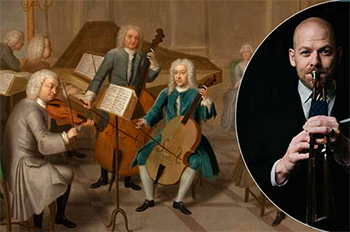by Peter Feher

A lively performance of four of the concertos at St. Paul’s Episcopal Church in Cleveland Heights on Friday, October 18 was the first of half a dozen outings for Apollo’s Fire this month (with slight changes in repertoire and personnel along the way).
Bach’s music, in all its consolations and complexities, could easily fill an ensemble’s entire schedule. In fact, that’s sort of what Apollo’s Fire has planned for 2024–25, with artistic director Jeannette Sorrell conceiving of the composer as a “guide star” for the season. The yearlong focus on Bach is set to conclude this spring in a “Bachanalia,” a full month of concerts and workshops around Northeast Ohio.
It’s fitting that the festivities should kick off this fall with the Brandenburgs. These concertos — undeniably brilliant works that nonetheless languished unperformed for much of their history — capture something of Bach’s imposing legacy. His compositions are demanding, and only recently (historically speaking) have their challenges come to be thought of as standard.
The very model of an ensemble like Apollo’s Fire — with the numbers of a small chamber orchestra yet the ability to highlight every individual player as a soloist — is a perfect case in point, as if the group were designed to tackle the technical demands of the Brandenburgs.
There were star turns to spare at St. Paul’s on Friday — both throughout the program and within any given piece. Violinist Alan Choo, in the splashy solo way he’s settled into with the ensemble, dispatched the scales in the first and third movements of No. 4 with extravagant ease. His showiness was complemented by the refined recorder playing of Kathryn Montoya and Kathie Stewart, who made an unwavering pair.
Trumpeter Caleb Hudson had the heavy lifting to do in No. 2, taking on the concerto’s daunting solo part with a period instrument (the piece is hard enough on a modern trumpet). Yet for all the effort he put in, Hudson sounded remarkably light, his tone somewhat similar to Montoya on recorder. Her poised performance stood out among the unique collection of soloists that this concerto calls for, with Choo and oboist Gaia Saetermoe-Howard on the other featured parts.
Bach’s idiosyncratic approach to instrumentation helps explain No. 6, which spotlights two violists, perhaps the least egotistically inclined of string players. Nicole Divall and Min-Young Kim were the soloists here, and they shone in individual moments but seemed mismatched as a duo, Divall’s sound often covering Kim’s.
No. 3 struck a more egalitarian balance, with each member of the nine-person string section on their own part, at once independent- and ensemble-minded. Sorrell conducted from the harpsichord with her characteristic mix of dynamism and deference, as she did the entire evening.
To open the concert, she led a spirited reading of the Ouverture from Bach’s Orchestral Suite No. 3, the one piece on the program that wasn’t a concerto. It was a showcase for Apollo’s Fire all the same.
Published on ClevelandClassical.com October 30, 2024
Click here for a printable copy of this article



